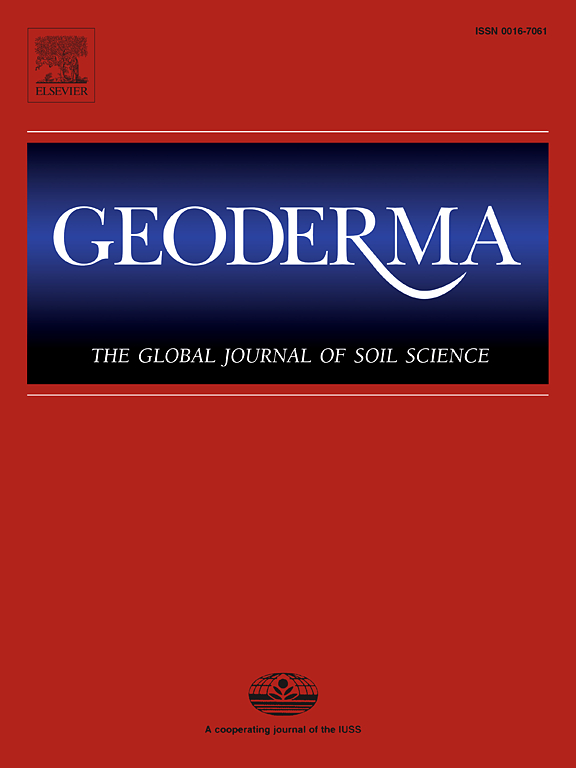利用地球观测策略绘制巴西粘土氧化物分馏图
IF 6.6
1区 农林科学
Q1 SOIL SCIENCE
引用次数: 0
摘要
热带土壤粘土组分中的主要氧化物是铁(Fe2O3)、铝(Al2O3)和硅(SiO2)氧化物,它们负责土壤提供多种生态系统服务的能力。因此,它们被用来将土壤划分为不同的土壤类型。尽管这些氧化物很重要,但大规模地对它们进行量化却面临着重大挑战。最常用的方法是实验室硫酸消化,这种方法昂贵、复杂,而且对环境有害。为了克服这些问题并提供更快的结果,我们开发了一种与机器学习(ML)相关的卫星技术,以30米分辨率绘制巴西所有农业区的Fe2O3, Al2O3和SiO2。此外,我们还测试了生成的地图在推断土壤风化和协助构建土壤学地图方面的可行性。预测使用了一个数据集,包括所有27个州的5330个站点(0-20厘米和80-100厘米)。利用随机森林算法,从历史Landsat系列(裸地)中获得的6个光谱变量和从数字高程模型中获得的7个地形属性,生成了Fe2O3、Al2O3和SiO2地图。预测的氧化物分布图覆盖了近348万平方公里(约占全国领土的40%)。对0 ~ 20 cm层中Fe2O3的预测效果最好(RMSE = 49.8 g.kg−1,RPIQ = 1.82, R2 = 0.62),而对80 ~ 100 cm层中SiO2的预测效果最差(RMSE = 65.3 g.kg−1,RPIQ = 1.50, R2 = 0.22)。利用Ki指数可以推测土壤风化。尽管模型没有显示出如此高的R2值,但结果与遗产图一致,在塞拉多生物群系的高原上观察到高度风化的土壤,而在干旱的Caatinga生物群系和潘塔纳尔生物群系中观察到较年轻的土壤。生成的地图还显示出对土壤分类进行分组的高潜力。他们还揭示了氧化物含量与甘蔗作物NDVI之间的关系,表明了在作物管理中的潜在应用。此外,这种基于卫星的技术,在ML的支持下,提供了一种合理的方法来预测大面积的高空间分辨率氧化分数。本文章由计算机程序翻译,如有差异,请以英文原文为准。
Mapping clay fraction oxides in Brazil using Earth observation strategy
The major oxides in the clay fraction of tropical soils are iron (Fe2O3), aluminum (Al2O3), and silicon (SiO2) oxides, which are responsible for the soil’s capacity to provide multiple ecosystem services. Therefore, they are used to classify the soils into different pedological classes. Despite their importance of these oxides, quantifying them on a large scale presents significant challenges. The most common method is laboratory sulfuric acid digestion, which is expensive, complex, and environmentally detrimental. To overcome these issues and provide faster results, we developed a satellite technique associated with machine learning (ML) to map Fe2O3, Al2O3, and SiO2 in all agricultural areas in Brazil at 30 m resolution. Additionally, we tested the feasibility of the generated maps to infer soil weathering, and assist in the construction of pedological maps. A dataset, comprising 5,330 sites (0–20 cm and 80–100 cm) across all 27 states was employed in prediction. Six spectral variables obtained from the historical Landsat series (bare soil) and seven terrain attributes derived from a digital elevation model were employed to generate the Fe2O3, Al2O3, and SiO2 maps, using the Random Forest algorithm. The predicted maps of oxides covered nearly 3.48 million km2 (∼40 % of the national territory). The best predictions were observed for Fe2O3 in the 0–20 cm layer (RMSE = 49.8 g.kg−1, RPIQ = 1.82, and R2 = 0.62), while the worst predictions were for SiO2 in the 80–100 cm layer (RMSE = 65.3 g.kg−1, RPIQ = 1.50 and R2 = 0.22). It was possible to infer soil weathering using the Ki index. Despite the models not showing such high R2 values, the results are aligned with legacy maps, highly weathered soils were observed in the plateaus of the Cerrado biome, while younger soils were observed in the arid Caatinga biome and waterlogged soils in the Pantanal biome. The generated maps also demonstrated a high potential for grouping pedological soil classes. They also revealed a relationship between oxide contents and the NDVI of sugarcane crops, indicating potential applications in crop management. Moreover, this satellite-based technique, supported by ML, presents a plausible approach to predict oxide fraction at high spatial resolution for large areas.
求助全文
通过发布文献求助,成功后即可免费获取论文全文。
去求助
来源期刊

Geoderma
农林科学-土壤科学
CiteScore
11.80
自引率
6.60%
发文量
597
审稿时长
58 days
期刊介绍:
Geoderma - the global journal of soil science - welcomes authors, readers and soil research from all parts of the world, encourages worldwide soil studies, and embraces all aspects of soil science and its associated pedagogy. The journal particularly welcomes interdisciplinary work focusing on dynamic soil processes and functions across space and time.
 求助内容:
求助内容: 应助结果提醒方式:
应助结果提醒方式:


